Did you know most of the content gets no traffic from Google? That’s because they skip keyword research.
Keyword research is one of the most valuable aspects of search engine optimization. It is crucial for all types of SEO, whether you’re a beginner, a professional, or an agency.
Without mastering keyword research, a digital marketer is unable to drive organic / paid traffic to their website or app.
If you want more people to find your website on Google, what can you do?
To assist you in this, we have created this comprehensive guide on SEO keyword research.
-> View how to conduct keyword research step-by-step!
But before we dive into keyword research methods, let’s address some basic questions about keywords.
What are keywords? And, what is keyword research?
When people type words or phrases into search engines like Google or Microsoft Bing to look for something, these typed words or phrases (user queries) are called keywords.
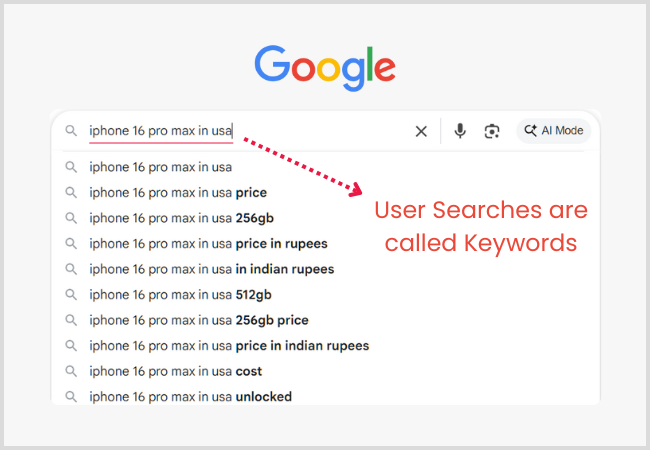
Keyword research is the process of recognizing and exploring the search phrases that people write or say into search engines.
Let’s try to understand with this example: “best running shoes” is a specific keyword.
However, the user’s intent behind this keyword is commercial, as users here attempt to gather information about the best running shoes available online before making their final purchasing decisions.
Why is keyword research important? And what benefits does it provide you?
Without keyword research, your SEO efforts are essentially blind shots; you’re taking a guess. With keyword research, you’re making wise decisions based on data.
Conducting keyword research is like discovering what your customers are thinking before they even visit the website.
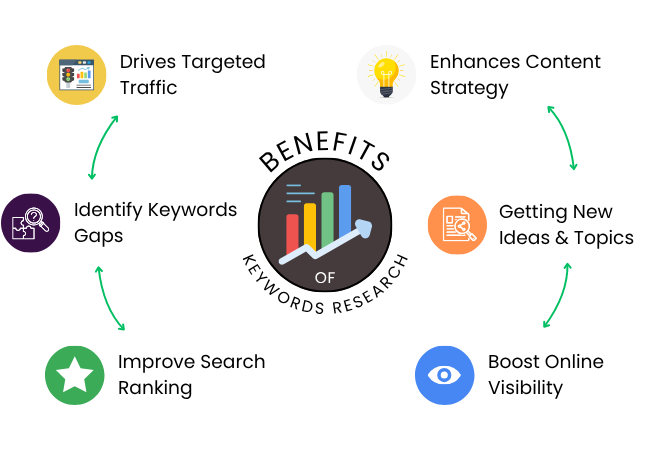
Keyword research helps you to achieve several important goals, including:
- Keyword ideas based on search terms that people are actively searching on Google.
- Generate ideas for blog topics and new pages that are relevant to your niche.
- Discover what people use to search for your products and services.
- Find long-tail keyword phrases, “low-hanging fruits,” that are easier to rank for.
- Optimize your content with related keywords, NLP keywords, LSI keywords & more.
- Identify keyword gaps from the competitors.
- Enhance the website’s presence in search engine results.
- Drive organic search traffic to your site.
- Attract more qualified leads.
Additionally, information about monthly search volume and traffic, along with keyword difficulty, will inform you that your keyword research for seo is in the right direction and focus on the most impactful keywords.
Understand Search Intent to Improve Keyword Research
Why People Search Matters for the SEO Strategy
When you understand the intent behind a search term that people enter into search engines, you can adjust your SEO strategy to meet their needs perfectly.
Are they trying to learn something? Buy something? Find a website?
For example, someone searching “how to tie a tie” means the user wants a tutorial, not a product.
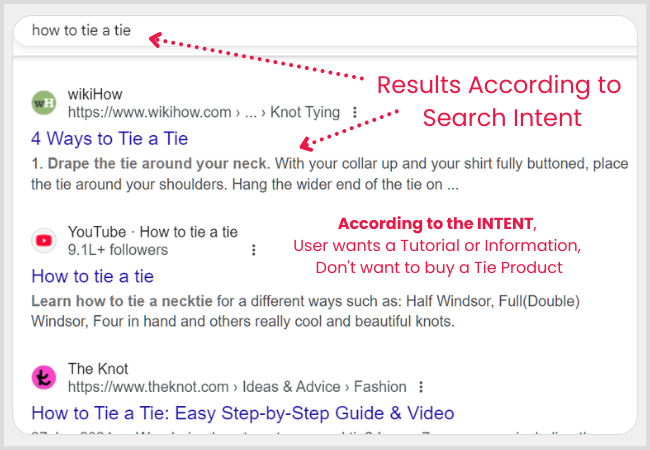
Aligning with search intent is vital for increasing rankings in search engine result pages to bring the right organic search traffic in this competitive age.
Types of Search Intent
Search intent can be broadly categorized. These categories include:
- Informational intent, which seeks knowledge or answers to questions (e.g., “What is SEO?“).
- Navigational intent refers to people finding a specific website or page (e.g., “Netflix Contact“).
- Transactional intent is driven by a desire to make a purchase (e.g., “buy sneakers online“).
- Commercial intent involves researching products or services before making a purchase (e.g., “best laptops under $500“).
Identifying the intent of a keyword enables you to create content that effectively satisfies the user’s needs. It is one of the best practices in SEO.
However, experienced SEO professionals recognized that search intent extends beyond just these four basic categories.
Aligning Keywords with User Intent
The key to successful SEO keyword research is matching or aligning your keyword strategy with search intent.
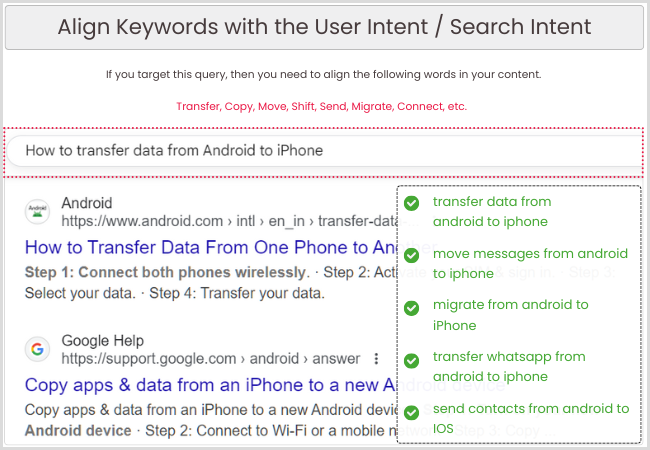
To align your content with search intent, type the keyword into Google and analyze the top-ranking results.
- If you see blog posts, create informational content.
- If product pages dominate, build a transactional landing page.
- And if comparisons or listicles appear, opt for content with a commercial intent, like “best of” or “review pages”.
Make your website content connect with what users are looking for, and improve your chances of ranking higher in search engines!
Pro Tip:
If your keywords differ from the user’s intent, Google won’t rank your page, even if you have optimized it perfectly.
How to Conduct Keyword Research for Keyword Clustering: Best Practices Explained
Step 1. Brainstorm Ideas for Focus Keyword:
Start by listing down topics relevant to your business or niche.
In this case, we target the “smartphone” niche and attempt to sell an “iPhone”.
A) Start with the Main Product:
Write down the core product name and variants such as:
- iPhone
- iPhone 15 Pro Max
- iPhone 14 refurbished
- Apple iPhone deals
These are your primary seed keywords.
B) Think like an iPhone Buyer. What related broad categories matter?
Here are a few you can start with:
- iPhone Buying Guides
- iPhone Price Comparison
- iPhone Accessories
- iPhone Reviews
- iPhone Deals & Offers
- iPhone vs Android
- iOS Tips & Tricks
- iPhone for Photography
- iPhone for Gaming
- iPhone for Students / Professionals
Pro Tip: We generated the above list using ChatGPT.
C) Use Google Autofill and Related Searches to Generate Ideas
Let’s try Google with the keyword “iPhone Deals in USA”.
Check:
- Autocomplete

- People Also Ask

- Related Searches
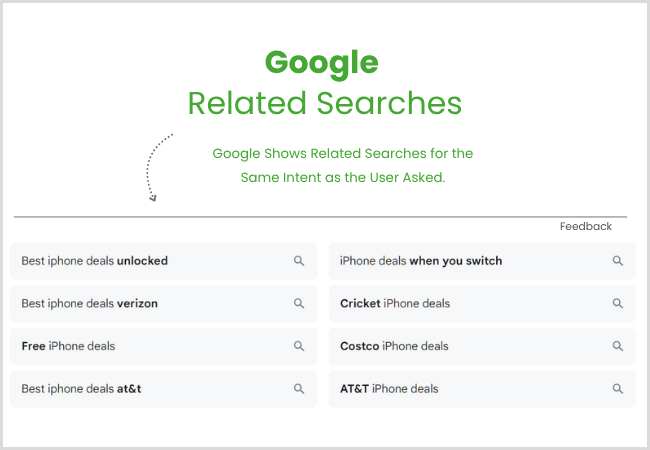
Step 2. Use Google Trends
It is a free tool that shows how popular a keyword or search term is over a specific period, which helps identify emerging subjects, recurring interests, and geo-specific relevance.
How to Use Google Trends:
- Go to Google Trends.
- Enter your relevant keyword in the search bar.
- Choose the country (e.g., United States) and timeframe (past 30 days, 12 months, etc.).
- Look at the trendline. This indicates whether the keyword gets high or low interest.
- Explore regional interest to identify high search areas.
- Check related topics and queries to find more relevant keyword opportunities.
- Compare up to five keywords (e.g., iPhone vs Pixel) to see which has higher search volume over time.
By analyzing the search traffic bucket to identify growing or seasonal interest, you can make data-driven decisions.
For instance, a spike in “best iPhones” serves as a clear source of keyword ideas for new content.
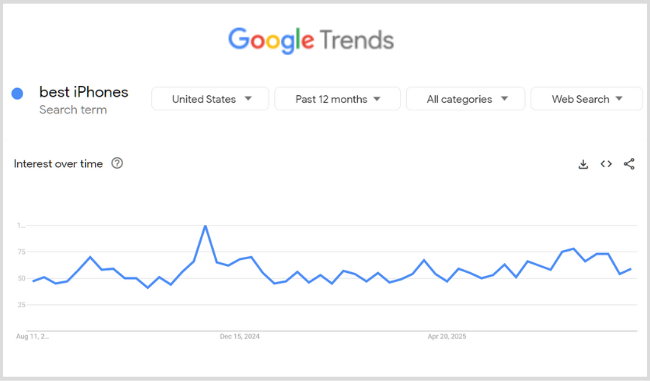
Pro Tip:
Experienced bloggers and SEO professionals use Google Trends to validate ideas before writing a piece of content because it’s an easy way to find the searches for a keyword in a specific time frame (day, week, month, or year).
Step 3. Use the Google Keyword Planner Tool
Google’s Keyword Planner is a website analytics software like Google Ads that helps you discover the highest search volume and competition metrics for any single keyword.
It’s part of the Google Ads platform, but you can still use it even if you’re not running paid campaigns.
How to Use the Google Keyword Planner:
- Sign in to Google Ads.
- Navigate to Google’s Keyword Planner under “Tools & Settings.”
- Choose “Discover new keywords” to enter your product or service (e.g., iPhone accessories).
- You’ll get keyword ideas, including search volume, competition, and trends.
- Use the “Get search volume and forecasts” option if you already have keyword ideas.
- Check the performance of each keyword under metrics like CPC and impressions.
You Can View the Complete Keyword Research Guide for Google Keyword Planner Here
The Keyword Planner is an excellent SEO tool for both beginners and pros. It provides keyword suggestions that are based on actual search results from Google.
This free keyword research platform is ideal for ranking in Google, as it provides insights into the organic search traffic bucket versus paid search trends.
You can even combine this with tools like Google Keyword Planner, such as Ahrefs Organic Keyword Tool, for deeper analysis.
Pro Tip:
Always use the keyword that best matches user intent, and try analyzing search terms that people already use on your site using Ahrefs Webmaster Tools or Google Analytics.
Step 4. Use Best Keyword Research Tools to Find Keywords SEO Metrics:
For deep and detailed keyword analysis, tools like Ubersuggest, Ahrefs, Moz, and SEMrush are helpful.
These tools provide essential keyword metrics such as search volume, number of clicks, cost-per-click (CPC), and competition on the keyword.
For Example:
Imagine you wish to rank your website on the “best iPhone” topics.
To achieve this, you need commercial intent blog topics with very low competition and higher search volume.
In this case, we use Ahrefs to find it. Look at the ahref step below:
Step 1: Go to Keywords Explorer and search for “best iPhone.”
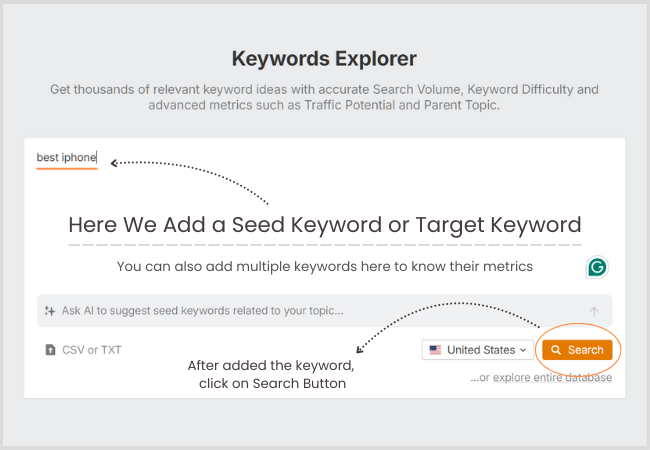
Step 2: Set limits to the filters for:
- Keyword Difficulty: 0-20 (easy to rank)
- Search Volume: 100+
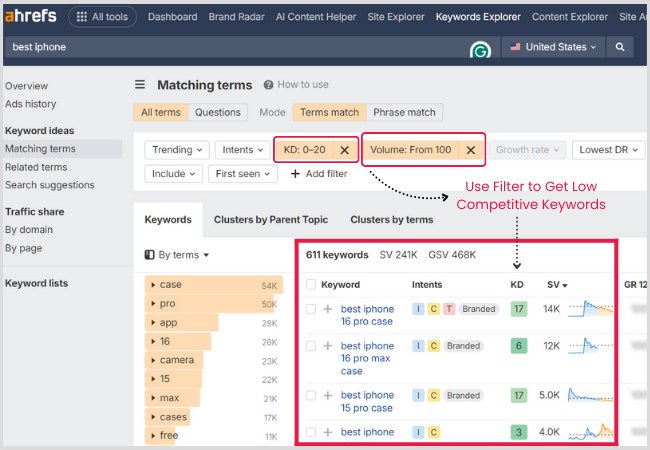
Step 3: Check Matching Terms & Questions like:
- Best VPN for iPhone
- Which iPhone has the Best Camera?

Step 4: Analyze the SERP to see what types of content are ranking (e.g., blog posts, product comparisons)
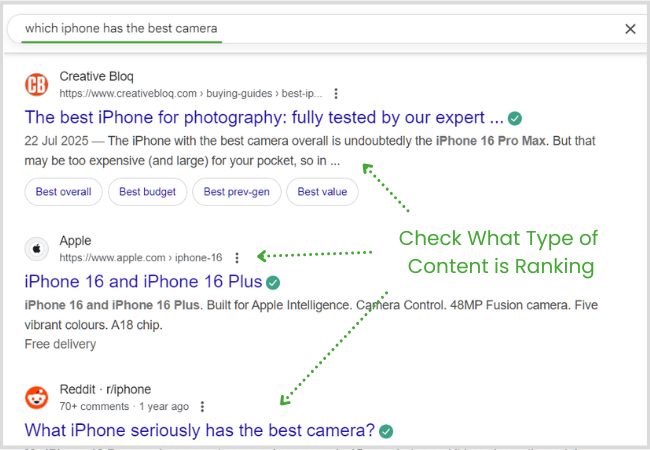
Step 5: Export the keywords or add them to a list for content planning.
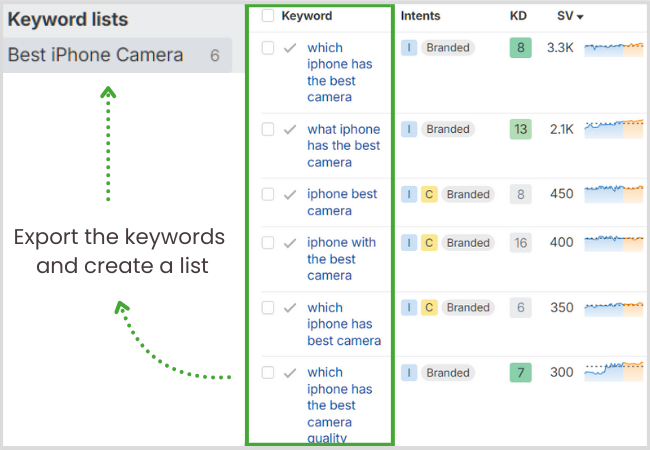
Check the Complete Keyword Research Guide of Ahrefs here.
For the rest of the keyword research tools, you can see complete step-by-step guides on their official websites:
After finding the keyword, break down the List of Keywords according to User Intent.
Group the seed topics into what users are trying to do:
- Informational – how to use iPhone, iPhone camera tips
- Commercial – best iPhone for Photography, iPhone vs Pixel
- Transactional – buy iPhone 15 Pro Max online, iPhone EMI offers
- Navigational – Apple official store, Amazon iPhone offers
Step 5. Analyze Competitors for Ranking Opportunities:
It’s more important to identify the keywords your competitors are ranking for so you can seize those opportunities.
For Example:
Let’s say you’re trying to sell iPhones through blogging and want to know which websites are already ranking for related keywords.
Here’s how to do competitor keyword research using Ahrefs:
(i): Go to “Site Explorer”
Enter a competitor’s domain.

(ii): Check the “Organic Keywords” report
See which keywords are bringing them the most traffic – filter by:
- Country: United States
- Position: 1–20
- Volume: 100+
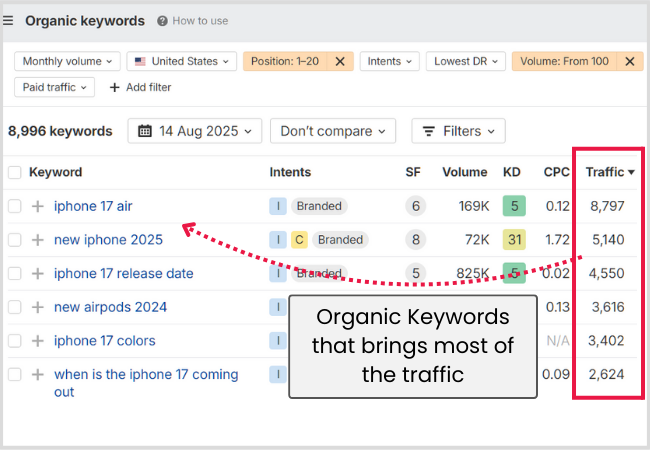
(iii): Use “Top Pages” to find their most visited blog posts.
Top pages help you understand what content format or topic is working for them.
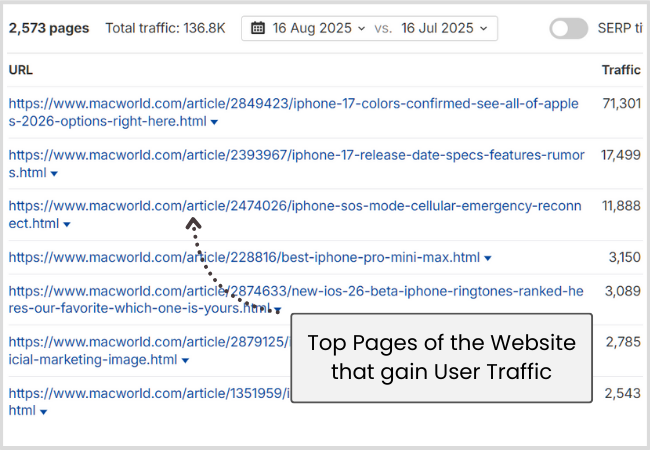
(iv): Go to “Content Gap”
Enter your website and then add 2–3 competitors.
Ahrefs will show keywords your competitors rank for—but you don’t.
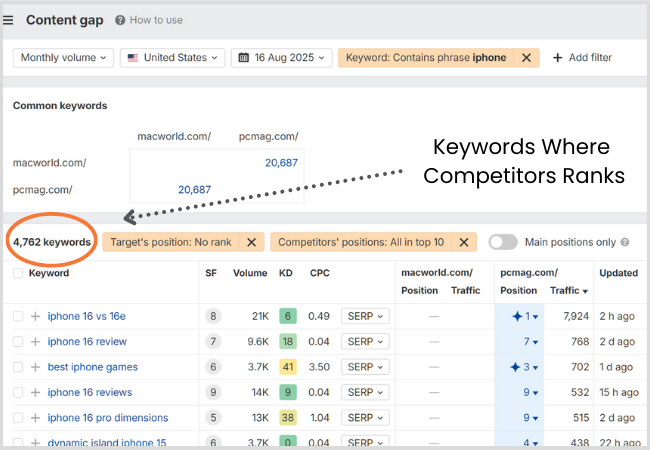
(v): Analyze Backlinks
Go to “Backlinks” and see which sites are linking to their iPhone-related content. You might find opportunities for outreach or guest posting.
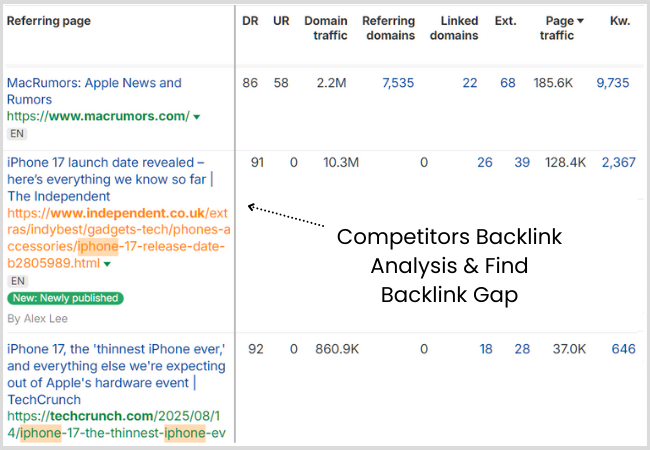
Check out the complete guide on competitor keyword research using Ahrefs.
Check out the step-by-step guide for the rest of the SEO keyword research tools here:
Step 6. Use Google Search Console for Accurate Keyword Research and SEO Improvement
Google Search Console (GSC): By using GSC in your keyword research, you get real data from Google, not guesses.
You can discover low-hanging keywords to target, update content to rank higher, and find new content ideas based on real searches.
GSC shows you:
- The exact search queries (keywords) people used.
- How many times has your site appeared (impressions)?
- How many times was it clicked?
- Your average ranking position for each keyword.
This data is super helpful because it tells you: what people are searching for, which keywords are already working for your site, and where you can improve your rankings.
Step 7. Refine Your List based on Keyword Difficulty and other essential SEO Metrics:
Prioritize keywords in your list that have a good balance of search volume and competition.
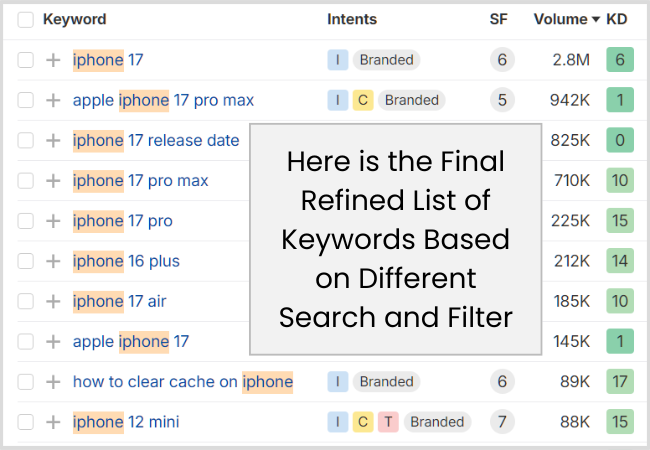
Congratulations! You’ve done the hard part.
Now, make the keyword cluster from your filtered keyword list. And, apply your SEO strategy to rank on them.
Pro Tip: How to do Keyword Optimization on Pages or Posts (Without Keyword Stuffing)
Once you have your keywords, it’s essential to use them effectively within your content.
- You should incorporate your main keyword into the title tag, meta description, URL slug, headline, and H1 tags.
- Include the variations, questions, NLP, or LSI keywords in the H2 to H3 Headings and the body content.
- Include additional keywords in the Image’s Alt text & internal links.
Aim for a natural flow that enhances readability.
If you want to know more about the keyword placement naturally in the content, then read our complete guide on how many SEO keywords to use per page.
Keyword Research Checklist
Use this checklist to ensure your keyword research process is complete.
- Brainstormed core topics and seed keywords related to your niche, product, or service.
- Used Google Autocomplete, “People Also Ask,” and “Related Searches” for keyword expansion.
- Explored Google Trends to identify trending, seasonal, or geo-specific keyword opportunities.
- Used at least one SEO keyword tool (Google Keyword Planner, Ahrefs, SEMrush, Moz, or Ubersuggest) for in-depth keyword data.
- Filtered keywords by Search Volume, Keyword Difficulty, Competition, and Click Potential.
- Grouped keywords based on Search Intent: Informational, Commercial, Transactional, Navigational.
- Aligned each keyword group with the correct content type (e.g., blog post, product page, comparison page).
- Analyzed top-ranking pages on Google SERP to validate keyword-user intent alignment.
- Conducted competitor keyword research using tools like Ahrefs’ Site Explorer or Content Gap analysis.
- Exported the keyword list and organized it by priority, target pages, and content clusters.
- Used Google Search Console to identify existing keyword opportunities and low-hanging fruit.
- Finalized keyword strategy with a focus on content relevance, user intent, and traffic potential.
Keyword Research Guide Conclusion
If you’re serious about improving your SEO game, mastering keyword research is non-negotiable.
Whether you are new to SEO or have experience, knowing how to use a keyword properly and choosing the right keywords to target will determine whether your content gets noticed—or buried.
Using keyword research helps you uncover what people are searching for on Google and Bing, allowing you to create content that aligns with real user intent.
Instead of guessing, you’re making informed decisions based on data.
When you’re looking at the search results, focus on the content type that’s ranking—because that tells you what users (and search engines) expect.
Tools like SEMrush’s Keyword Magic Tool, Ahrefs’ Keywords Explorer Tool, or analytics software like Google Analytics can guide your strategy and help you find keyword opportunities that your competitors might be missing.
To rank for in Google, focus on keywords with high search volume but manageable competition.
That balance can often be your best chance at ranking for a keyword that drives results.
Don’t forget, once you’ve selected your keywords, you need to optimize your content using solid on-page SEO practices.
And write content naturally—without stuffing many keyword phrases into one article.
In a world filled with popular search terms and changing trends, the right tools can help you stay ahead.
Take the time to plan, analyze, and execute.
When done right, keyword research isn’t just a task—it’s a strategic advantage that leads to more traffic, better rankings, and ultimately, business growth.
FAQs
Q1) How is keyword research different for beginners vs. agencies?
Ans: Beginners often focus on finding basic, low-competition keywords, while agencies use advanced tools, keyword gap analysis, and competitor data to build scalable SEO strategies.
Q2) What’s the difference between keyword research for local SEO vs. global SEO?
Ans: Local SEO targets location-based keywords like “dentist near me,” while global SEO focuses on broader, high-volume terms for international audiences.
Q3) Should keyword research be done once or continuously?
Ans: Keyword research is an ongoing process, as trends, SERPs, and competitors change. Reviewing keyword lists every 2–3 months is best practice.






